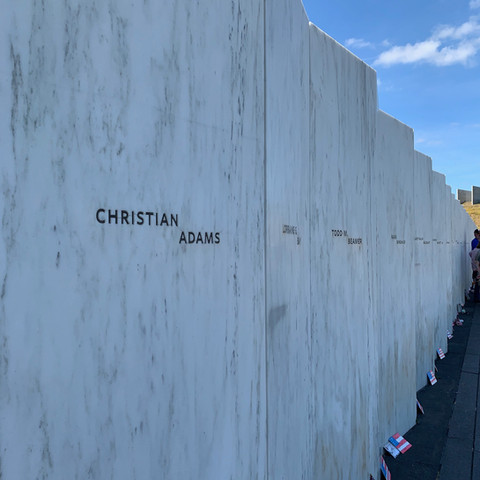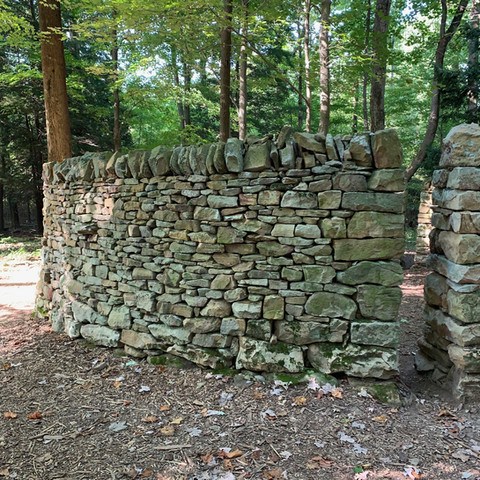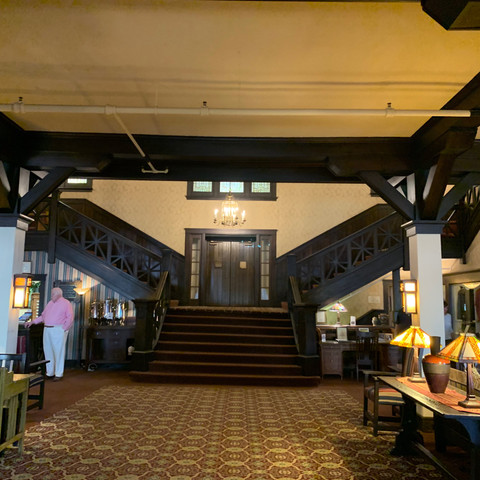Recently, I booked the new British Airway's direct flight London to Pittsburgh, USA. The plane for my flight was new and clean, the staff friendly the flight was easy. And not have to take a connecting flight is always positive!
For our annual 'Sister Week' visits, my sisters and I travel together each year with set criteria for our trip; A good spa, lots of wine, good walks and hiking, good wine and optional good food. Toss in some sightseeing, laughter-inducing adventure and a cocktail or two, and you have a perfect sisterly getaway. I was eager to try the BA direct flight from London, so we set about rediscovering the joys of Western Pennsylvania and our home town, Pittsburgh.
Pittsburgh has a lot going on, and if you are a sports lover, food lover, art lover, culture lover or architect aficionado, there is a lot to explore. You'll have the best bratwurst and pirogies you've had, and chase that down with an ice-cold Iron City Beer. We began our week with a day in the city, featuring several trips down many a memory lane. Then for the next three days, we explored the towns, villages and natural beauty of Fayette and Somerset Counties, Pennsylvania.
DAY TWO
Not far from our lodgings at the Nemacolin Woodlands Resort, Farmington, are Flight 93 Memorial Park, Fort Necessity, the Historic Summit Inn and Frank Lloyd Wright's Falling Water and Kentuck Knob. Furthermore, close by are the natural beauty spots Laurel Mountains and Caverns and the rolling rapids at Ohiopyle State Park.
When I say things are not far, you must consider our lack of navigational skills and plan your travel time accordingly. 'Smug Directions Phyl' usually has no need for and insists she needs not GPS advice while traveling, but we seem to get lost an awful lot on these Sister Week trips. True, the risky off-road experiences are, as a whole, entirely my fault. But occasionally, I am not 100% to blame.

First on our list of things to see was the Fight 93 Memorial Park, in Shanksville. Thanks to my trusty TomTom, the same ancient bit of gear that once led our car down a pedestrian cliffside in the pouring rain in the Taos Mountains, we found the park with ease. Had we been using GPS equipment more current than a 10-year-old TomTom, we may have found the entrance as well.
Tom led us to a disused entrance and refused to guide us to one that was open to the public. It took 30 minutes, driving up and down Lincoln Highway while gazing over treetops at the roof of a concrete structure we knew was the destination that we just could not reach, to find the public entrance. Once securely inside the park, it amazed us to see so many people not looking lost, stressed or even remotely snarky with one another. They must have just used GoogleMaps.
On September 11, 2001, highjacked flight United 93 crashed into a field of ash trees as the passengers aboard fought for survival. 44 people died in the field on that day; 33 passengers, seven crew and four terrorists.
Flight 93 Memorial Park is 400 acres surrounded by 1800 acres of government and privately owned land. The Visitor's Center sits on a hill above the crash. From here you can join the Allee', a walk planted with 40 groves of maple and eastern white oak trees which leads you to the lower information centre and the crash site.
A low black slate wall marks the edge of the site. A symbolic gate, carved from ash, frames the sandstone boulder that marks the site of impact. The Wall of Names consists of 40 interconnecting granite slabs carved with the victims' names and inlaid with ash. 40 observational benches face the wall.
The Tower of Voices is the gateway to the park. This concrete sculptural piece is 93 feet high (for Flight 93) and will have 40 wind chimes, one voice for each passenger.
The Flight 93 Memorial is solemn and respectful. It is a beautiful spot that commemorates an ugly event and very much worth a visit. Perhaps even get lost with people you love before arriving.
TomTom rerouted, we set off to find famed architect Frank Lloyd Wright's Kentuck Knob. My sisters and I have visited FLW's UNESCO World Heritage sites Taliesin West, Hollyhock House and Fallingwater, and several churches and homes in Chicago. Kentuck Knob, in Chalk Hill, is close to Fallingwater and worthy of a visit in its own right.
One happy USA road trip tradition of mine is stopping by Dunkin Donuts for a box of donut holes, or Munchkins. My kids would love these little fried balls of dough so much they would have one each from a box of 24 and then leave the remaining 21 Munchkins for me to devour while driving.

My sisters acquiesced and agreed to drive-through for a respectable Munchkin 12 pack. We finally spotted a Dunkin' at a busy intersection. But this Dunkin' seemed to lack a penetrable drive-through entrance. We were, for the second time that day, forced to drive in circles on Lincoln Highway. Marcia, designated driver, dipped disappointingly in and out of adjacent but utterly disconnected parking lots, running several of the yellow lights that controlled traffic in this mystical cloverleaf. Please don't grass about the stoplights. But if you do, tell the police not to bother with a Munchkin 12-pack post 2:00pm. My Munchkins were disappointing stale and not worth the sugar spike. I abandoned the box to the back seat of the car with a good half dozen still intact.
'Give me the luxuries of life, and I will willingly do without the necessities.'
-Frank Lloyd Wright, clearly discussing Dunkin' Munchkins

Frank Lloyd Wright is the most famous American architect and the home he designed for the Kaufmann family, Fallingwater, might be the most famous house ever built.
I.N. and Bernadine Hagen fell in love with Fallingwater and begged Lloyd-Wright, then aged 86 and building both the Guggenheim Museum in New York and the Beth Shalom Synagog in Elkins Park, PA., to create a home for them in nearby Chalk Hills.
Designed on a hexagonal module, Kentuck Knob is a small, one-story Usonian house. Usonian, meaning affordable for the average American, was a signature design of Frank Lloyd Wright. This is ironic, as having a designer house can hardly have been affordable, on average. The house is both dramatic and serene. It sits below the crest of the hill and appears almost part of the mountain itself.
Beyond the back terrace, is a breathtaking view of the Youghiogheny River Gorge and the beautiful Laurel Highlands mountains that surround it.

Kentuck Knob’s building materials are native sandstone and tidewater red cypress. This helps the house to blend naturally with the surroundings. The kitchen is the architectural core of the home. Its walls of stone not only anchor the two wings of the house, but they also rise to penetrate the horizontal line of the copper roof. The house has an open floor plan, cantilevered overhangs, and great expanses of glass that integrate the indoors with the out.
The Hagen family sold the house in 1986 to English Lord Peter Palumbo. He and his wife established a sculpture garden on the grounds featuring over 30 works from international artists (including another slice of the Berlin Wall). While the Palumbo's still spend time at the house, they also open it to the public for tours and rentals.
The visitor's centre welcomes visitors with red phone boxes and birdhouses to recall its British ownership. From here, you can enjoy a woodland walk to the house, taking in the nature and art along the way. Or you can take a service bus. Had we been sensible and taken the bus service, we would have been loaned fans for shooshing the approximately 12 billion woodland gnats brought out of hibernation by the unusually warm Autumn weather. But we walked and thus had no shooshing apparatus. The gnats were so thick, traversing the rock pathway was a little bit tricky. It's hard to swat a swarm of small flying insects and not trip over a wet rock all at the same time.
One lucky group of tourists had the aforementioned bus-gnat-fans. My sister Marcia, who has a wonderful gift of speaking with strangers, queried the purchase of a fan to a fanner who generously gave her his fan. She lived in peace for our remaining 40 minutes in that forest, while Phyl and I suffered. Feeling that Kentuck Knob should loan the fans to everyone with a ticket; not just those on the bus and especially to those enjoying the gnat-filled forest romp, we kept that fan.
Knackered from our day of crying, laughing, upper arm gnat-swatting exercising, driving befuddlement and all-around emotional tourism, we returned to the Nemacolin Woodlands Resort to rest up for day three of Sister Week; Spa Day.
DAY FOUR

We woke early the next morning with the usual debate of what to have for breakfast, and wandered the palatial hotel in searching for carb-free grub.
Marcia suggested we go to PJ's Café for ice cream because ice cream is good for breakfast. A debate raged on between the merits of her science, but we had ice cream for breakfast anyway.
The first stop on our Sister Week, Day Four itinerary was Fort Necessity. When we were children, luxury travel was an unheard concept in our neighbourhood. Our travel destinations included Kennywood Park, Lake Erie, Ohiopyle State Park and Fort Necessity, all found less than two hours away from home.

I remember Fort Necessity by photo proxy only. But my sisters have fond memories of posing on covered wagons with our cousins. Our educated, sensible parents controlled the childish impulse to re-enact Westward Expansion (cowboys v. Indians), and encouraged the more historically appropriate French & Indian War play instead. In our dresses, sun hats with funky patterns and built in sunglasses and white Keds plimsoles, I am sure we all looked the part.

In the spring of 1754, competing claims over ownership of the Ohio Territory between the English and the French had reached their climax. The British sent requests for a French departure, one hand-delivered by a young George Washington.
From his position at Fort Necessity, Washington planned an ambush of the French camped not far away. This small skirmish left ten French soldiers dead and another 20 held prisoner.
On the morning of July 3, 500 French soldiers and 100 Native Americans descended in retaliation on Fort Necessity. Washington surrendered and the British vacated the fort, ironically, on 4 July.

Fort Necessity, a small, shabby wooden circle in the middle of a Pennsylvania field, has bravely defeated the elements for 265 years while symbolising the abject failure of the man who, 33 years later, would become the country's first elected president. I'm not sure what part covered wagons played in this.
We had places to be, and neither sister were interested in a stop at the Mt. Washington Tavern. I wanted a few pictures for this blog, so Marcia parked by the road and I jumped over the guardrail to get a clear shot of the house. To my surprise, the house was unlocked and completely unguarded. I entered. I am keen to try new things, but I didn't consider trespassing against a House of Historic Interest would be on the cards for that day.
For reasons known only to George Washington, he bought the land next to the site of his first military defeat. The first National Road, 1818, ran from Baltimore, Maryland to St. Louis Missouri ran along side this property which includes the Mt. Washington Tavern and the Historic Summit Inn. Had Washington not died 19 years earlier, he would have made a bomb.
The Mt. Washington was a working tavern and hostel. The owning family lived on the premises, loaned out rooms on a nightly basis, and also offered food and drink. It was a popular meeting place in its time. Docents regularly regale to visitors the ghost stories and legends of the Mt. Washington Tavern. But the docents were not there and I was trespassing without paying an entry fee. Before I became a ghost of someone who had died choking on a pub carvery dinner, I got the heck out of there.

Near the Mt. Washington Tavern, is the Historic Summit Inn. The Inn served as a tavern along the National Road for many years until the Summit Hotel Company purchased and updated the inn in the early 19th century. American's Industrial Revolution in Pittsburgh churned out millionaires faster than steel. All these newly monied people needed country houses where to they could escape the filthy air they themselves had created.
Reopened as the Summit Inn in 1907, this hotel had the first outdoor olympic-sized swimming pool in the USA. It was also the meeting place of the American Science Wizards- a comic con of sorts for inventors. Henry Ford, Harvey Firestone and Thomas Edison all previewed their inventions at the Summit Inn.
Today, the Summit Inn is one of the last remaining grand porch hotels in America. It is fully operational and boasts a high degree of history and luxurious country living. It also has great views of the valley, and Union Town below.


With our time together, I like to annoy my sisters by challenging them into something they don't want to. Marcia, who is afraid of heights, didn't appreciate zip lining in Vermont. Phyl, who is claustrophobic, was not pleased with exploring slate mines in Wales. But my sisters eventually do these things, and I am very proud.
This year, to shake things up a bit, we planned on two uncomfortable physical adventures for us to absolutely not enjoy. So far on this trip, we had done a good job of exploring the natural beauty, history, and the chicken wing restaurants of the Laurel Highlands. Now it was time to do something deeper; explore the Laurel Caverns.
Laurel Caverns is a large natural calcareous sandstone cave located not far from Farmington. The passage ceilings in its three mile labyrinth are between 10-20 feet high with some as high as 50 feet. The average width of the passages are over twelve feet, and is the largest cave in Pennsylvania and the largest sandstone cave in the world. The cave and the 435 acres of geological preserve it lays beneath, are privately owned by the Cale family.

There are three tours on offer:
The traditional tour is for families with children and takes one hour. Upper caving is more rigorous and takes two hours. Lower caving is very rigorous and takes visitors the entire three miles to the bottom of the mountain. Using our inappropriate footwear as an excuse for our little effort, my sisters and I opted out of lower cave spelunking in favour of the family tour. It was quite fun and the average temperature of 52 F/12 C was a great relief from the raging heatwave outside.
The cave is 70% silica with 30% calcium carbonate which gives it soft walls and an ever-changing appearance. The tour guide likened the creation of the passages; groundwater dissolving the calcium and then washing away the silica, to that of what Coke does to your teeth. That fact turned me right off Coke all the way until lunch. The cave is 46 stories deep with a 13-degree tilt. This makes for a fun, not to be missed, subterranean optical illusion involving a ping pong ball.
Laurel Caverns is also the largest natural bat hibernaculum in the north-eastern United States. For bat preservation, the cave is closes during winter months for the winter hibernation season. It would have been scary and perhaps a bit ugly. And that would be us sisters, and not the bats.
DAY FIVE
With our Sister Week trip throughout Western Pennsylvania nearly over, Phyl, Marcia and I headed to another childhood vacation spot. Each summer we had a backyard home-made slide show of the four of us skipping stones, jumping over the rocks, and paddling through the shallows of the Youghiogheny River at Ohiopyle.

On our final day, we went rafting on the Lower Yough. The first time we went rafting together, was on the Rio Grande in New Mexico, where mis-adventure abounded. Foolishly empowered and invigorated by the rapids, I jumped into the water and needed to be hoisted back into the raft, as I didn’t have the upper body strength I thought I did.

Funny thing about boats and water. Just when you think you can do anything, you are slapped with the impossible task of hoisting yourself up from an unsupported dog paddle into a pillow of plastic, filled with people you don't know, bobbing along in choppy water.
This rafting trip was more of the same, in that it began with anxious whimpering, then screaming, and ended with agonising groans. Though, now that I am a 'world-famous' travel blogger, this time I stayed in the boat and away from shame.
As no one else on the boat would help end my shame, my sisters alone hauled me into the boat by my life jacket straps. It was a gruesome affair. You don't want to know where I ended up, but the above picture gives some indication.
The Youghiogheny River, aLanape for 'a stream flowing in a contrary direction', is a 134-mile (216 km) tributary of the Monoghela River. It runs through West Virginia and Maryland, entering southwestern Pennsylvania between Fayette and Somerset counties. Nicknamed the Yough, the river is popular for whitewater canoeing, kayaking, and rafting. It is also great for fishing, brimming with brown and rainbow trout.
Ohiopyle State Park encompasses over 20,500 acres of rugged wilderness and serves as a gateway to the Laurel Highland Mountains. There are natural waterslides in the river at Meadow Run, Cucumber Falls waterfall, hiking trails and hiking and biking on the Great Allegheny Passage. You can sleep under the stars at Kentuck Campsite, picnic with a view at Tharp Knob and explore rare plants and fossils on Ferncliff Peninsula. Nature is Bliss at Ohiopyle.
For whitewater recreation, the river is sectioned into Top, Upper, Middle and Lower Yough, and the runs vary in difficulty. Further downstream, the river is slower and can be piloted by personal tubes, kayaks, or canoes. Best to have a guide for the rough stuff.
The Lower Yough runs through Ohiopyle State Park from Ohiopyle to Bruner Run (Class III). This section is the busiest whitewater trip east of the Mississippi River, with over 250,000 visitor each year.

We were all feeling doubtful of our abilities as adventure tourists. The weather had turned rainy and cold and secretly, I believe we were all wishing for a downpour that morning to make cancellation a viable option. However, the weather was clear enough and we made the trip to Ohiopyle.
And after a quick safety run-through and a mad dash through the gift shop, we changed into our wetsuits, which are great equalisers, by the way, as they are unflattering on most people, and climbed aboard the red inflatable raft with Dave from Wilderness Voyageurs.
Though rainy, cloudy and cold, it was beautiful being on the river. I could imagine life as it was for the Lanape tribe, silently navigating the course of the river. That was until the mountains rumbled with the booming wrath of the Western Maryland Railway trains, chugging along on the tracks high above.
In Autumn, the water on the river is low and slower moving. We were called upon occasionally to paddle forward or backward, but mostly, we held oars at the ready, waiting for instruction from Dave. He did the grafting while we giggled about wetsuit overhang, foggy glasses and the dangerous combination of endless water and weak bladders.
Dave was a very generous raft guide. He understood our nervousness and told us the pitfalls of each rapid only seconds before we approached, when it was too late to escape. He then enjoyed regaling us with tales of people who didn't make it past those rapids after we had passed them by.

Although the Yough is safe for whitewater recreation, there have been 19 deaths on the river. From five to 14 fatalities have occurred at the Dimple; a class III rapid with an undercut rock.
Nine deaths are attributed to preexisting health issues. Neither of these alternatives were comforting as we bounced across rocks in a rubber dingy, engaging our withered core muscles as we clung to the inside of the boat with our toes and our glut muscles.
As part of the booking, Wilderness Voyageurs offers a light meal. This can be had picnic style by the riverbank, or at their shop in town. Having returned to the shop, Dave set out a beautiful spread for us to eat. And with all the hard work he was doing on the river, we were starving! The bummer thing was that Dave had forgotten to take the food out of the freezer and, while we were a bit frozen, so was our food. It didn't matter, it was perfect. Besides, I had stale Dunkin' Donut Munchkins, squirrelled away in the back seat of the car.
Marcia before and Marcia after whitewater rafting
I love my sisters, and I love our time together. Next year: hiking the entire circumference of Menorca, Balearic Islands, Spain
Flight 93 Memorial Park: 6424 Lincoln Highway, Stoystown, PA 15563. Shanksville vicinity, Stonycreek Township, Somerset County.
Fallingwater: 1491 Mill Run Road, Mill Run, PA 15464
Kentuck Knob: 723 Kentuck Road, Dunbar, PA 15431
Fort Necessity: National Park, Farmington PA 15437 www.mtvernon.com www.nps.gov
Historic Summit Inn: 101 Skyline Drive, Farmington PA 15437 www.summitinnresort.com
Laurel Caverns Park: 1065 Skyline Drive, Farmington PA 15437 www.laurelcavernspark.com
www.wilderness-voyageurs.com
#FortNecessity #LaurelCaverns #HistoricSummitInn #WesternPennsylvania #NemacolinWoodlandsResort #Icecreamforbreakfast #momentsofmine #traveladdict #wanderlust #roadtripusa #visitpennsylvania #pennsylvaniatourism #GeorgeWashington #spelunking #caves #bats #historytravel #FrenchIndianWar
#pennsylvania #pittsburgh #visitpa #patourism #roadtripusa #Fallingwater #Kentuckknob #Flight93memorialPark #wanderlust #momentsofmine #explore #adventure #solotravel #roamtheplanet #luxlife #traveladdict #luxurytravel #BritishAirways #oldbagonplane #whitewaterrafting #ohiopyle #wildernessvoyageurs
We had places to be, and neither sister were interested in a stop at the Mt. Washington Tavern. I wanted a few pictures for this blog, so Marcia parked by the road and I jumped over the guardrail to get a clear shot of the house. To my surprise, the house was unlocked and completely unguarded. I entered. I am keen to try new things, but I didn't consider trespassing against a House of Historic Interest would be on the cards for that day.















































































































Comments